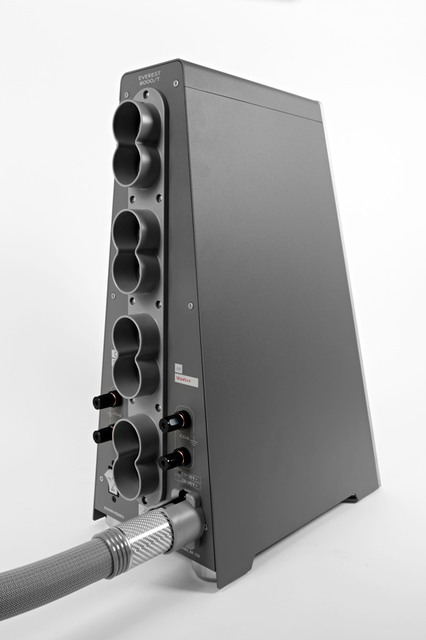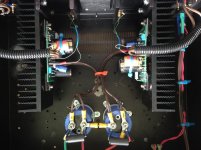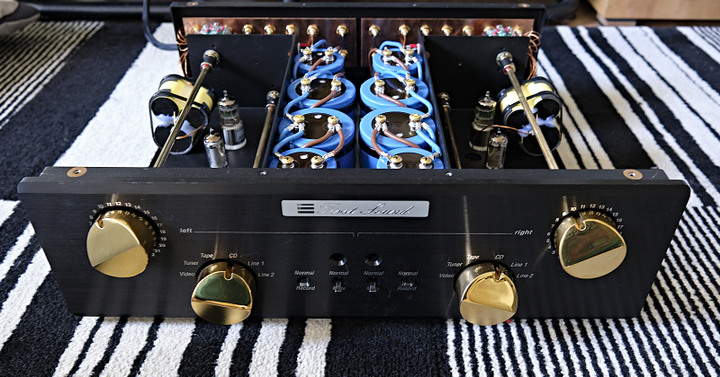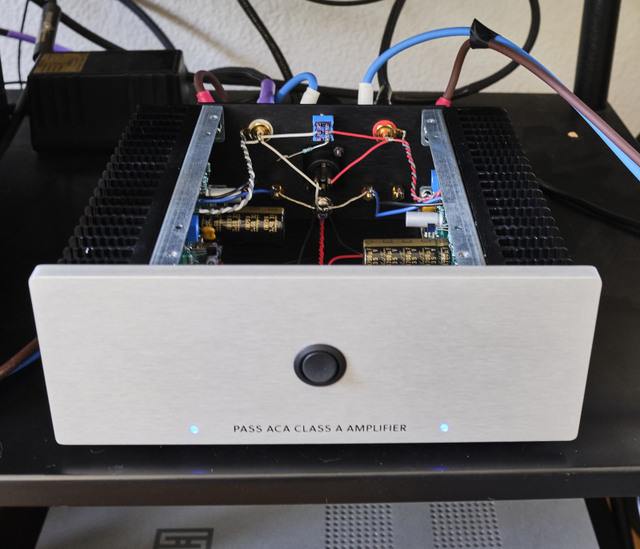Our member’s contributions to help others are the huge “value added” to the amp designs and kits that are available here either at the store or from group buys or just schematics.
Until yesterday I had completely missed the fact that Puma was caught in the midst of the transition when there was very little info available as to the new model. My bad on that. It’s pretty obvious to US why we made the change, (of course!) and now that more info is out should be obvious to everyone what advantages the new model has to many builders. Some builders might prefer to stick with the simpler wiring of the previous models. In that case I still suggest installing the switch to fill the hole so it doesn’t get lost in case later you want to upgrade....
Until yesterday I had completely missed the fact that Puma was caught in the midst of the transition when there was very little info available as to the new model. My bad on that. It’s pretty obvious to US why we made the change, (of course!) and now that more info is out should be obvious to everyone what advantages the new model has to many builders. Some builders might prefer to stick with the simpler wiring of the previous models. In that case I still suggest installing the switch to fill the hole so it doesn’t get lost in case later you want to upgrade....
Last edited:
Variac said:Our member’s contributions to help others are the huge “value added” to the amp designs and kits that are available here either at the store or from group buys or just schematics.
Until yesterday I had completely missed the fact that Puma was caught in the midst of the transition when there was very little info available as to the new model. My bad on that.
It's all good. In my view, the community as a whole is better served by these discussions.
As for my input and "confusion", that's okay, too. I learned some good stuff.
Moving up the Ladder of Abstraction here, when I used teach Six Sigma, I used to teach the principle of kaizen, which loosely translated from the Japanese, means, "Change for the Better." One of the key principles of kaizen is the philosophy of "Continuous Improvement."
A short fable...
As a Master Black Belt in Biotech, I used to get called in to many projects and teams at work, when big problems cropped up in Operations, or when processes or products that amounted to tens of millions of dollars of revenue were breaking...the teams would go, "Oh, sh*t, we don't know what's going on...get Stephen in here."
Now, it was natural in these circumstances for the stakeholders and the various teams involved from Management, R&D, and Ops to start pointing fingers and blaming each other, in these situations, nothing would get solved, folks would get angry and stressed, and to put the icing on the cake, the Execs come in around this time and start punishing everyone (sidebar: and many times, it was the Execs that changed or mandated something started the fires in the first place. I had coined a term for this called, "Executive Arson").
Of course, none of this behavior solved the problems. I would start by leading the teams in activities to get to the heart of the problem by focusing on the the "process" rather than the "people", e.g., team-based activities like process mapping, KJ diagrams, and FMEA, with kaizen as the over-arching philosophy. And, invariably, folks would calm down, stop pointing fingers, get on with the kaizen project, and, guess what? We'd get it sussed. Then, we'd all go out for sushi! 😀
I see this discussion in the same way: we learned some stuff, gained some insight and we have some clear direction on how we can make help DIYGuides...change for the better. Kaizen. So, It's all good! 🙂
I'm happy to be here and have learned a lot from you guys already. With respect improving the various build guides, collating information, providing photography for the build guides, or anything else, feel free to reach out, I'm happy to help out.
You guys are great. Many thanks! 😀
Last edited:
The problem is, there are new projects getting generated all the time, and none of us are getting paid a single cent to do this.
The extra time it takes to go from 80% perfect to 100% perfect in doing a manual or build guide is just too much investment of ones time.
By the time 6L6 or other person gets it 80% perfect, a new project comes along and he is under pressure to finish that, and the circle of life starts all over.
Basically the community here fills in the gaps for the imperfections of the manual/build guide.
I honestly don't see anything changing from how it runs right now.
It is a little painful for a first time builder I agree, but that period passes by soon enough.
The extra time it takes to go from 80% perfect to 100% perfect in doing a manual or build guide is just too much investment of ones time.
By the time 6L6 or other person gets it 80% perfect, a new project comes along and he is under pressure to finish that, and the circle of life starts all over.
Basically the community here fills in the gaps for the imperfections of the manual/build guide.
I honestly don't see anything changing from how it runs right now.
It is a little painful for a first time builder I agree, but that period passes by soon enough.
Last edited:
I am sorry if this question had been asked. Had Anyone here built an aca amp using more expensive parts and can you hear any differences if any?
This is worth reading
Resistor Types - Does It Matter?
sound of things
Everything in the circuit is a part of the sound that you hear. The positions of the component in the circuit can have varying impact, but it is a soup. Lots of variables, and then the $$ to be considered. All of this is known, but is all part of
the fun and discovery of DIY🙂
Everything in the circuit is a part of the sound that you hear. The positions of the component in the circuit can have varying impact, but it is a soup. Lots of variables, and then the $$ to be considered. All of this is known, but is all part of
the fun and discovery of DIY🙂
Thanks, Jason.
PS: I've been to Melbourne a couple of times; in 2004 and 2005 to photograph the MotoGP at Philip Island with credentials (I'm also a motorsports photojournalist).
Melbourne says hi.
Jon Stevens - Take Me Back | Live From Eddie's Desk! | The Hot Breakfast - YouTube
Very clean, nicely done!!
🙂 🙂 🙂
Neatness counts, and you have made an outstanding example for people to emulate!
🙂 🙂 🙂
Neatness counts, and you have made an outstanding example for people to emulate!
Thanks, Jim. And thanks to the DIYAudio Pass Labs gang for all their help.
I'll finish up the other amp tomorrow and run these bad boys as bridged monoblocks. 😀
If you guys want any of these or other photos, for reference or for build guides, just let me know. Also, I'll be taking ACA in the product photography studio in my spare bedroom and doing some professional product shots of it with lights, seamless and all...
Some examples of my work...



I'll finish up the other amp tomorrow and run these bad boys as bridged monoblocks. 😀
If you guys want any of these or other photos, for reference or for build guides, just let me know. Also, I'll be taking ACA in the product photography studio in my spare bedroom and doing some professional product shots of it with lights, seamless and all...
Some examples of my work...



Last edited:
dfoulk said:Mr. Puma,
Never a substitute for Quality!!!
Nice work, and thanks for sharing
Den
Thank you, Den.
Cheers, mate.
A hearty return Cheers to you
The Amp Camp Amp is a Great piece of equipment. I have had a few amps,
but it is my very favorite of them all!

The Amp Camp Amp is a Great piece of equipment. I have had a few amps,
but it is my very favorite of them all!
Hi back!
A shot from the MotoGP when I was there...
Awesome photo
In the rack, making music as I type this...
Hi Puma Cat,
I ended up mounting mine inside an old B&K ST-140 case with the final filter caps, 33,000uf a channel. The kit heat sinks are bolted to the heat sinks in the B&K case.
 The first stage of the power supply which has the transformer, rectifiers, filter chokes, and first bank of filter caps, 27,200uf for each channel, is in a separate case, which out puts 30 volts DC through a 3 conductor wire that goes to the amp proper.
The first stage of the power supply which has the transformer, rectifiers, filter chokes, and first bank of filter caps, 27,200uf for each channel, is in a separate case, which out puts 30 volts DC through a 3 conductor wire that goes to the amp proper.dfoulk said:Hi Puma Cat
I ended up mounting mine inside an old B&K ST-140 case with the final filter caps, 33,000uf a channel. The kit heat sinks are bolted to the heat sinks in the B&K case. The first stage of the power supply which has the transformer, rectifiers, filter chokes, and first bank of filter caps, 27,200uf for each channel, is in a separate case, which out puts 30 volts DC through a 3 conductor wire that goes to the amp proper.
Hi Den,
Thanks for the pics and sharing your insight. I may want to build an external PS like yours sometime; would you be open to sharing your schematic, plans, and a Bill of Materials?
BTW, you may find this of interest...this is one of the two external PS for my First Sound dual mono preamp. Each channel of the pre has 145,200 uF of capacitance. If you look carefully at the lower and upper left corners you can see the proprietary Shunyata Research MDPA AC noise filters that first sound uses.

This is the preamp "control unit"...even more capacitance. LOL.

- Home
- Amplifiers
- Pass Labs
- ACA amp with premium parts




